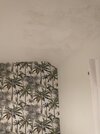- Joined
- 11 Dec 2023
- Messages
- 5
- Reaction score
- 0
- Country

Hi all,
First off - I've read the pinned condensation in loft thread and I reckon that answers my condensation / insulation related questions but have 3 Qs for those more experienced than me! I live in a Victorian terrace and I'm getting issues with condensation damp on my bedroom ceiling and can also see moisture on the inside of the roofing membrane in the loft. The upstairs is also much colder than downstairs and loses heat exceptionally quickly.

Q1 - What material do I even have already / should I replace it?
I know that it is installed wrong in attached pic - should be parallel between joints and perpendicular above them rather than all laid parallel to joists. What is still a bit of a mystery to me is what sort of material it is - most of the insulation material is in silver and orange bags but otherwise unlabelled. Some is just dumped loose.
a) What is it?
b) Should it still be in those bags?
c) Is it appropriate for a house of my age? (should I look to replace with a hygroscopic insulation - e.g. wool?)

Q2 - Is this roofing membrane part of the problem?
The bedroom on the other side of the house doesn't have any of the same issues with damp on the slanted parts of the ceiling, not only is the insulation not pushed right up against the eaves but it seems all the roofing membrane is some sort of matte material whereas on the side with the issue there's a lot of what appears to be plastic.
Non-problem side (felt?):

Problem side (some felt, some plastic?):

Q3 - Are the eaves properly ventilated?
There are two ventilation tiles in the actual roof, but I can't tell from the above pic (or one below from outside) where the eaves ventilation is supposed to be.
Would a house of this age typically have ventilated eaves (and if so I guess I need to clean them out) and if not - would more ventilation tiles help?

First off - I've read the pinned condensation in loft thread and I reckon that answers my condensation / insulation related questions but have 3 Qs for those more experienced than me! I live in a Victorian terrace and I'm getting issues with condensation damp on my bedroom ceiling and can also see moisture on the inside of the roofing membrane in the loft. The upstairs is also much colder than downstairs and loses heat exceptionally quickly.
Q1 - What material do I even have already / should I replace it?
I know that it is installed wrong in attached pic - should be parallel between joints and perpendicular above them rather than all laid parallel to joists. What is still a bit of a mystery to me is what sort of material it is - most of the insulation material is in silver and orange bags but otherwise unlabelled. Some is just dumped loose.
a) What is it?
b) Should it still be in those bags?
c) Is it appropriate for a house of my age? (should I look to replace with a hygroscopic insulation - e.g. wool?)
Q2 - Is this roofing membrane part of the problem?
The bedroom on the other side of the house doesn't have any of the same issues with damp on the slanted parts of the ceiling, not only is the insulation not pushed right up against the eaves but it seems all the roofing membrane is some sort of matte material whereas on the side with the issue there's a lot of what appears to be plastic.
Non-problem side (felt?):
Problem side (some felt, some plastic?):
Q3 - Are the eaves properly ventilated?
There are two ventilation tiles in the actual roof, but I can't tell from the above pic (or one below from outside) where the eaves ventilation is supposed to be.
Would a house of this age typically have ventilated eaves (and if so I guess I need to clean them out) and if not - would more ventilation tiles help?

